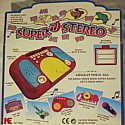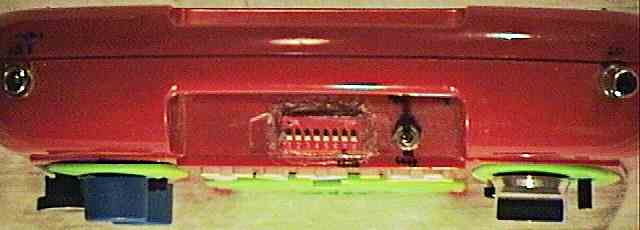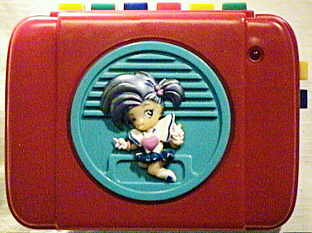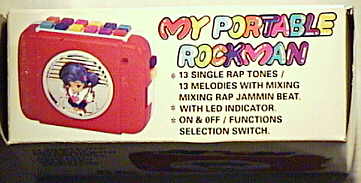 |
 |
| Super Stereo | sound toy with rhythm loops, piano and animal samples |
 |
 |

In rhythm mode a standard rhythm pattern is running continuously and
any press of a "drum" or "animal" button plays 1x an alternate rhythm pattern
depending on the pressed button. All alternate rhythms and demo melodies
play in a loop when their button is held down.
circuit bending detailsThis was one of the first instruments I had modded. I had done here quite traditional circuit bending, that has nothing to do with (anyway absent) matrix eastereggs.Danger: The conductive layer of these silicone buttons is extremely thin, though by the abrasion of multiple assemble and dismantle cycles and my attempts to clean the badly working contacts (by rubbing etc.) I finally destroyed the layer completely (Arrg! 8-[ ). In the shop where I once had bought the toy, they only had left a single, bleached out specimen with broken "CD" lid. Fortunately I managed to transplant its silicone keypad to my circuit- bent instrument. Halting the CPU clock will fry the plastic loudspeaker. All buttons are sensed by 6 lines those react on VCC (=+4. 5V). Instead of a matrix, this awful hardware senses combinations of multiple simultaneous input lines pulled to VCC as different key inputs, though each rubber key presses against multiple contacts, i.e. when a key is pressed too weakly (or contacts are dirty), the wrong(!) sound is played. (This kind of keyboard hardware seems to be also quite common in toy mobile phones.) For the 8 DIP switch block I had to wirewrap a bundle of very thin wires to the fragile PCB without destroying the tiny, tinned PCB contacts for the silicone buttons. Due to the buttons respond bad (wrong sounds) I tried to solder some diodes on the tiny PCB to remove the need of connecting multiple contacts for each button, but it hadn't much success (possibly due to the voltage drop of diodes. I added a "drumroll" pot, which makes a feedback from the lamp output to the DIP switch with an electrolytic cap and though re-triggers a pattern again and again with each n-th flash by simulating fast button presses. (This function behaves a bit unpredictable when other pots are turned, but this makes it also interesting for experimental music.). I added a click effect pot from a lamp output; it is routed through a DIP switch to avoid distortion when off. The resulting instrument can make quite versatile, grainy tekkno rhythms, and the sound CPU can be ridiculously overclocked without crashing until the rhythm turns into a continuous beep. Never the less I added an opener button switch in the CPU supply voltage as reset to stop rhythm. |
 |
 |
| removal of these screws voids warranty... | ||
 |
||
|
|